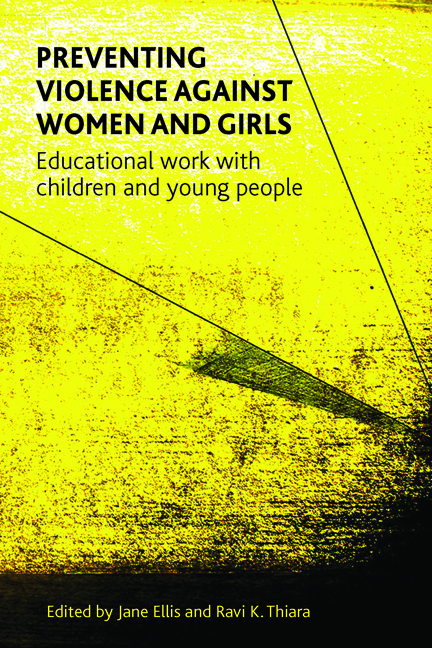Book contents
- Frontmatter
- Dedication
- Contents
- List of tables and figures
- Notes on contributors
- Acknowledgements
- Foreword
- Introduction
- one Preventing violence against women and girls through education: dilemmas and challenges
- two Does gender matter in violence prevention programmes?
- three Responding to sexual violence in girls’ intimate relationships: the role of schools
- four ‘Pandora’s Box’: preventing violence against black and minority ethnic women and girls
- five Preventing violence against women and girls: a whole school approach
- six What did you learn at school today? Education for prevention
- seven No silent witnesses: strategies in schools to empower and support disclosure
- eight Preventing sexual violence: the role of the voluntary sector
- nine ‘Boys think girls are toys’: sexual exploitation and young people
- ten MsUnderstood: the benefits of engaging young women in antiviolence work
- eleven Shifting Boundaries: lessons on relationships for students in middle school
- Concluding remarks
- Appendix: Examples of programmes in the UK
- Index
ten - MsUnderstood: the benefits of engaging young women in antiviolence work
Published online by Cambridge University Press: 04 March 2022
- Frontmatter
- Dedication
- Contents
- List of tables and figures
- Notes on contributors
- Acknowledgements
- Foreword
- Introduction
- one Preventing violence against women and girls through education: dilemmas and challenges
- two Does gender matter in violence prevention programmes?
- three Responding to sexual violence in girls’ intimate relationships: the role of schools
- four ‘Pandora’s Box’: preventing violence against black and minority ethnic women and girls
- five Preventing violence against women and girls: a whole school approach
- six What did you learn at school today? Education for prevention
- seven No silent witnesses: strategies in schools to empower and support disclosure
- eight Preventing sexual violence: the role of the voluntary sector
- nine ‘Boys think girls are toys’: sexual exploitation and young people
- ten MsUnderstood: the benefits of engaging young women in antiviolence work
- eleven Shifting Boundaries: lessons on relationships for students in middle school
- Concluding remarks
- Appendix: Examples of programmes in the UK
- Index
Summary
Drawing on research the author is conducting at the University of Bedfordshire and the outcomes of a pilot programme, ‘The Gendered Action on Gangs (GAG) Project’, which trained young women to influence local policy and services, this chapter will explain the process, and consider the benefits, of ‘gender-proofing’ antiviolence work through the engagement of young women. Using Bourdieu's theory of social fields and agency, the chapter: outlines key policy and research on peer-on-peer abuse generally and on serious youth violence specifically; assesses the relevance of serious youth violence policy and practice to the lived experiences of gang-affected young women; considers the benefits and challenges of engaging gang-affected young women in policy and service development; and discusses the means by which different agencies could directly engage young women in antiviolence work in the future. Finally, the chapter also considers the potential for applying this approach to engaging boys and young men in antiviolence work and explores whether there is a role for young men in preventing gang-related violence against young women.
Introduction
From 2008 onwards, evidence has been generated on the impact of street gangs and serious youth violence on women and girls across England (Pitts, 2008; Firmin, 2010, 2011, 2013a; Pearce and Pitts, 2011; Beckett et al, 2012; Berelowitz et al, 2012). While regional and national policy has increased recognition of the impact of gang violence on women and girls, consistent local responses are yet to develop (DCSF, 2010; GLA, 2010; HM Government, 2011, 2013). These inconsistencies are rooted in broader challenges in acknowledging, understanding, and conceptualising young people's experiences of gender-based violence specifically, and gendered identities and hierarchies more generally. As a response, in 2010 ‘The GAG Project’ was piloted to engage gang-affected girls and young women in local policy and practice development. This pilot project advocated a gender-proofed approach to working with gang-affected girls within a youth offending service, and it challenged local agencies to improve their strategic and operational responses to violence affecting young women.
Impact of street gangs and serious youth violence on women and girls
“I’m scared that I’ve forgotten how to feel things. I don't cry any more. One of my boys got killed and I couldn't even cry at the funeral. You learn not to care cos there's no point.
- Type
- Chapter
- Information
- Preventing Violence against Women and GirlsEducational Work with Children and Young People, pp. 205 - 224Publisher: Bristol University PressPrint publication year: 2014

